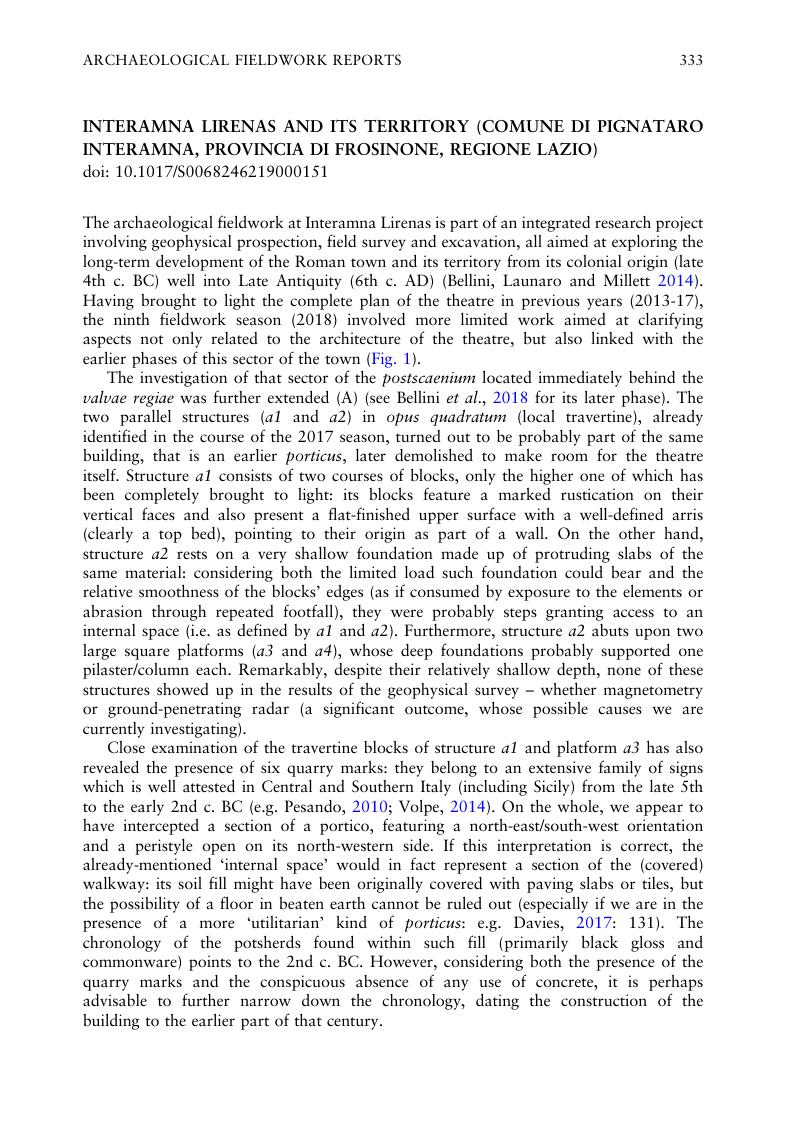No CrossRef data available.
Article contents
INTERAMNA LIRENAS AND ITS TERRITORY (COMUNE DI PIGNATARO INTERAMNA, PROVINCIA DI FROSINONE, REGIONE LAZIO)
Published online by Cambridge University Press: 21 October 2019
Abstract
An abstract is not available for this content so a preview has been provided. Please use the Get access link above for information on how to access this content.

- Type
- Archaeological Fieldwork Reports
- Information
- Copyright
- Copyright © British School at Rome 2019
References
Ballantyne, R., Bellini, G.R., Launaro, A., Leone, N. and Millett, M. (2015) Interamna Lirenas. Papers of the British School at Rome 83: 299–302.Google Scholar
Bellini, G.R, Launaro, A., Leone, N., Millett, M., Verdonck, L. and Vermeulen, F. (2017) Interamna Lirenas. Papers of the British School at Rome 85: 321–24.Google Scholar
Bellini, G.R, Launaro, A., Leone, N., Millett, M., Verdonck, L. and Vermeulen, F. (2018) Interamna Lirenas. Papers of the British School at Rome 86: 303–6.Google Scholar
Bellini, G.R, Launaro, A. and Millett, M. (2014) Roman colonial landscapes: Interamna Lirenas and its territory through Antiquity. In Stek, T.D. and Pelgrom, J. (eds) Roman Republican Colonisation: New Perspectives from Archaeology and Ancient History, 255–75. Rome, Palombi Editori.Google Scholar
Bellini, G.R, Launaro, A. and Millett, M. (eds) (in preparation) Interamna Lirenas: A Roman Town and its Hinterland, 350 BC to AD 550. Cambridge, McDonald Institute.Google Scholar
Davies, P.J.E. (2017) Architecture and Politics in Republican Rome. Cambridge, Cambridge University Press.Google Scholar
Pesando, F. (2010) Quadratariorum notae pompeianae. Sigle di cantiere e marche di cava nelle domus vesuviane. Vesuviana 2: 47–75.Google Scholar
Volpe, R. (2014) Dalle cave della via Tiberina alle mura repubblicane di Roma. In Bonetto, J., Camporeale, S. and Pizzo, A. (eds) Arqueología de la construcción IV. Las canteras en el mundo antiguo: sistemas de explotación y procesos productivos. Mérida: Consejo Superior de Investigaciones Científicas, Instituto de Arqueologia. 59–71.Google Scholar


